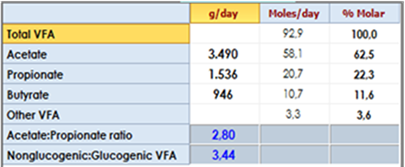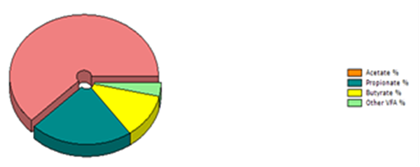

The volatile fatty acids (VFA) produced by microbial fermentation in the rumen are the main source of energy absorbed by the digestive tract of ruminants. The amount and profile of VFA formed in the rumen has consequences for the efficiency of energy utilization, production of methane, risks of ruminal acidosis and composition of animal products.
Using an empirical approach, the NDS Ruminal pH sub-model provides a quantitative review on VFA yield in the rumen, based on several dietary parameters (Nozière et al., 2011).




In addition, Acetate to Propionate ratio (AP) and Nonglucogenic to Glucogenic (NGR) ratio are reported.
The NGR ratio seems to be of significant interest because the VFA profile, particularly the nonglucogenic (Acetate, Ac; Butyrate, Bu) to glucogenic (Propionate, Pr) VFA ratio (NGR), is associated with effects on methane production, milk composition, and energy balance.
To integrate the four individual VFA into one characteristic, the nonglucogenic to glucogenic VFA ratio (NGR) was calculated as [Ac + 2 x Bu + Branched chain VFA] / [Pr + Branched chain VFA].
According to the definition of this ratio, observed NGR is positively correlated with Acetate and Butyrate and negatively with Propionate. The NGR is related to the efficiency with which VFA are used for productive purposes, as it provides an indication of the partitioning of energy between milk and body mass.
The NDS Ruminal pH Sub-Model developed by the NDS team as described above, is not a component of the underlying CNCPS model, and does not change the model outputs or results. It is solely an implementation and the responsibility of RUM&N Company.